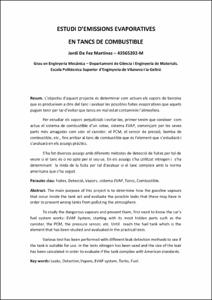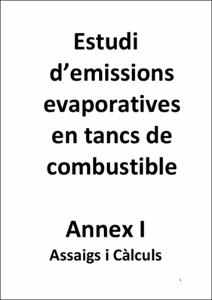Mostra el registre d'ítem simple
Estudi de les emissions evaporatives en tancs de combustible
| dc.contributor | Picas Barrachina, Josep Anton |
| dc.contributor.author | De Fez Martinez, Jordi |
| dc.contributor.other | Universitat Politècnica de Catalunya. Departament de Ciència i Enginyeria de Materials |
| dc.date.accessioned | 2020-03-25T10:35:36Z |
| dc.date.available | 2020-03-25T10:35:36Z |
| dc.date.issued | 2020-02-05 |
| dc.identifier.uri | http://hdl.handle.net/2117/181272 |
| dc.description.abstract | [CATALÀ] Avui en dia, en el món on ens ha tocat viure, la tecnologia avança un ritme trepidant, i tots aquests avenços tecnològics tenen les seves parts positives i negatives. Una d’aquestes parts negatives és la contaminació, i més concretament la contaminació que es genera per part de l’automoció, la industria pertinent o relativa a l’automòbil. El canvi climàtic és un fet evident que afecta a tota la societat, és per això que des de la industria de l’automoció s’ha intentat reduir les emissions contaminants. Les accions com la implantació del cotxe elèctric, la utilització de carburants alternatius, l’aplicació de normatives i lleis més estrictes pels fabricants de cotxes són petits avenços cap a un futur més sostenible. L’objectiu d’aquest projecte és la detecció de fuites en tancs de combustible per tal de reduir qualsevol tipus de contaminació i així aportar el meu granet de sorra per a contribuir a un planeta més net. En aquest projecte s’estudien les diferents parts del sistema de combustible per tal de saber com funcionen, tot seguit s’avaluaran els diferents mètodes que es poden utilitzar per dur a terme la detecció i posteriorment fer unes proves experimentals amb dos mètodes de detecció per tal de veure les possibles fuites i la mida d’aquestes i considerar si són acceptables o no segons la normativa específica que s’hi apliqui. Els dos assaigs principals seran el primer, una caiguda de pressió on es controlarà la pròpia pressió de dins del tanc per determinar les fuites que aquest pot tenir. El segon assaig és més complex, consistirà en utilitzar nitrogen (N2) injectant-lo en el tanc i controlant diversos paràmetres com la temperatura, la pressió i el cabal de nitrogen per detectar fuites amb diversos aparells més sofisticats. Finalment, s’estudia l’impacte mediambiental que aquest projecte tindrà a l’hora de realitzar les proves de fuites. També s’inclou un pressupost detallat de tota la instrumentació i material que s’ha necessitat per a la realització d’aquest projecte. |
| dc.description.abstract | [ANGLÈS] Nowadays, in the world where we live, technology advances at a fast pace, and all these technological advances have their positive and negative sides. One of these negative parts is pollution, and more specifically the pollution generated by the automotive industry, the relevant or relative to the automobile. Climate change is an obvious fact that affects all people, which is why, from the automotive industry, it has been tried to reduce polluting emissions in order to curb this change. Actions such as the implementation of the electric car, the use of alternative fuels, the application of stricter regulations and laws by car manufacturers, etc. that are small advances towards a more sustainable future. The objective of this project is the detection of leaks in fuel tanks in order to avoid and reduce any type of pollution and thus contribute to a cleaner planet Firstly, the different parts of the fuel system will be studied in order to know how they work, then the different methods that can be used to carry out the detection will be evaluated and then perform experimental tests with two methods of detection in order to See the possible leaks and their size and consider whether they are acceptable or not according to the specific regulations. The two main tests will be the first, a pressure drop where the pressure inside the tank will be controlled to determine the leakage it may have. The second test is more complex, it will consist of using nitrogen (N2) to inject it into the tank and control various parameters such as temperature, pressure and nitrogen flow to detect leaks In addition, the environmental impact that the project can have at the same time as the leakage tests together with a detailed budget of all the instrumentation and necessary material will be studied. |
| dc.language.iso | cat |
| dc.publisher | Universitat Politècnica de Catalunya |
| dc.rights | Attribution 3.0 Spain |
| dc.rights.uri | http://creativecommons.org/licenses/by/3.0/es/ |
| dc.subject | Àrees temàtiques de la UPC::Desenvolupament humà i sostenible::Degradació ambiental::Contaminació atmosfèrica |
| dc.subject | Àrees temàtiques de la UPC::Enginyeria mecànica |
| dc.subject.lcsh | Fuel tanks |
| dc.subject.other | Emissions |
| dc.subject.other | Tancs |
| dc.subject.other | Fuites |
| dc.subject.other | Combustible |
| dc.subject.other | Detecció |
| dc.title | Estudi de les emissions evaporatives en tancs de combustible |
| dc.type | Bachelor thesis |
| dc.subject.lemac | Combustibles -- Contaminació |
| dc.subject.lemac | Combustibles -- Emmagatzematge |
| dc.subject.lemac | Automòbils -- Contaminació |
| dc.identifier.slug | PRISMA-150430 |
| dc.rights.access | Open Access |
| dc.date.updated | 2020-03-23T10:43:28Z |
| dc.audience.educationlevel | Grau |
| dc.audience.mediator | Escola Politècnica Superior d'Enginyeria de Vilanova i la Geltrú |
| dc.audience.degree | GRAU EN ENGINYERIA MECÀNICA (Pla 2009) |




